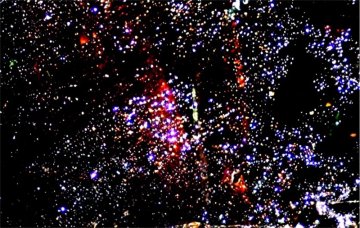 Autumn is here, and it's a wonderful time for stargazing. Find out what's up from Spaceweather PHONE.
Autumn is here, and it's a wonderful time for stargazing. Find out what's up from Spaceweather PHONE.
LOW-HANGING PLANETS: When the sun goes down tonight, step outside and look west. If you have a clear view of the horizon, you'll see Mercury, Jupiter and the slender crescent Moon beaming through the glow of sunset--very pretty. [sky map] [photos: #1, #2, #3]
FADING SUNSPOT: Easy come, easy go. Sunspot 917 exploded into being on Oct 21st, growing from near-invisibility to a crackling active region the size of Neptune in less than 24 hours. Today, almost as quickly, the sunspot is fading away:

Three days of sunspot 917. Credit: SOHO
If you have a solar telescope, keep an eye on developments. This could be a good opportunity to observe a sunspot as it breaks apart.
more images: from Cameran Ashraf of Claremont, California; from John C McConnell of Maghaberry, Northern Ireland; from John Stetson of Falmouth, Maine.
NAME THAT CLUSTER: Can you identify this star cluster? Hint: It's very close to Earth. Scroll down for the answer.

It's a spider's web!
California photographer Mila Zinkova explains: "The blue stars are dew drops hanging on the strands of the web and lit by the morning sun. The orange nebulas are autumn leaves. When I showed this underexposed picture to my husband, he said 'it looks like stars.'" Indeed it does. Compare Mila's picture to Hubble images of NGC 290 and the Quintuplet Cluster.
A slightly longer exposure reveals the strands of the web and the orange leaves: image. It really is a spider's creation--just call it "The Arachnid Cluster."
PS. Apologies for the trick question.

